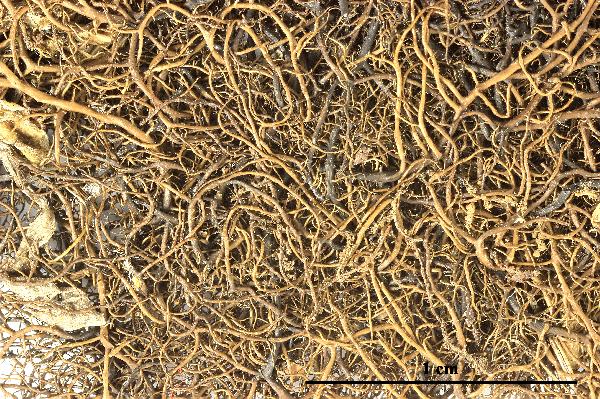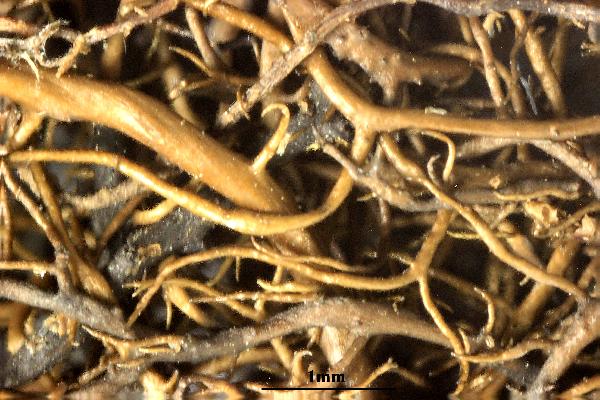Bryoria bicolor (Ehrh.) Brodo & D. Hawksw.
Opera Bot., 42: 99, 1977. Basionym: Lichen bicolor Ehrh. - Hannover. Mag., 22: 161, 1784.
Synonyms: Alectoria bicolor (Ehrh.) Nyl.; Bryopogon bicolor (Ehrh.) Elenkin; Bryopogon jubatus var. bicolor (Ehrh.) Rabenh.; Cornicularia bicolor (Ehrh.) Ach.
Distribution: N - Frl (TSB 5284), Ven, TAA (Nascimbene & al. 2007b, 2022), Lomb, Piem (Isocrono & al. 2004).
Description: Thallus fruticose, filamentous, loosely attached, erect to caespitose, rigid, without a main branch, usually with perpendicular, 0.2-0.5 mm thick branches, black at the base, often brownish black in terminal parts, with olive-grey to pale brown, often shiny apices, and with dark, often arcuate lateral spinules, esorediate. Pseudocyphellae sparse, fusiform, brown, level with thallus or slightly raised; medulla white, compact. Apothecia extremely rare (never observed in Italian material), zeorine, with a brown disc, to 3 mm across. Asci 8-spored, Lecanora-type. Ascospores 1-celled, hyaline, globose to broadly ellipsoid, 6-9 x 4-6 μm. Photobiont chlorococcoid. Spot tests: cortex and medulla K- or K+ yellowish slowly turning brown, C-, KC-, P+ red. Chemistry: fumarprotocetraric acid.Note: a mainly boreal-montane, circumpolar lichen found on mossy trunks of old, more or less isolated trees in mountain areas with frequent fog, sometimes on mossy rocks.
Growth form: Fruticose filamentous
Substrata: bark
Photobiont: green algae other than Trentepohlia
Reproductive strategy: mainly asexual, by thallus fragmentation
Most common in areas with a humid-warm climate (e.g. most of Tyrrenian Italy)
Commonnes-rarity: (info)
Alpine belt: absent
Subalpine belt: rare
Oromediterranean belt: absent
Montane belt: rare
Submediterranean belt: absent
Padanian area: absent
Humid submediterranean belt: absent
Humid mediterranean belt: absent
Dry mediterranean belt: absent

Predictive model
Herbarium samples


Felix Schumm - CC BY-SA 4.0
[VZ1443], URSS. Osetia Septentrionalis. Caucasus Magnus, distr.
Ordžonikidze, in valle rivi 30 km in occidente av urbe Ordžonikidze,
loco Katrmaidon dicto, 1800 m. Supra muscos in rupibus siliceis. Leg.
E. Lisická-Jelínková. EX VEZDA: LICHENES SELECTI EXSICCATI NR.
1443.


Felix Schumm - CC BY-SA 4.0
[VZ1443], URSS. Osetia Septentrionalis. Caucasus Magnus, distr.
Ordžonikidze, in valle rivi 30 km in occidente av urbe Ordžonikidze,
loco Katrmaidon dicto, 1800 m. Supra muscos in rupibus siliceis. Leg.
E. Lisická-Jelínková. EX VEZDA: LICHENES SELECTI EXSICCATI NR.
1443.


Curtis Randall Björk, - CC BY-SA 4.0
Near Masset, Haida Gwaii Island, British Columbia, Canada
08.10.2018
Growth form: Fruticose filamentous
Substrata: bark
Photobiont: green algae other than Trentepohlia
Reproductive strategy: mainly asexual, by thallus fragmentation
Most common in areas with a humid-warm climate (e.g. most of Tyrrenian Italy)
Commonnes-rarity: (info)
Alpine belt: absent
Subalpine belt: rare
Oromediterranean belt: absent
Montane belt: rare
Submediterranean belt: absent
Padanian area: absent
Humid submediterranean belt: absent
Humid mediterranean belt: absent
Dry mediterranean belt: absent

Predictive model
| Herbarium samples |


Felix Schumm - CC BY-SA 4.0
[VZ1443], URSS. Osetia Septentrionalis. Caucasus Magnus, distr. Ordžonikidze, in valle rivi 30 km in occidente av urbe Ordžonikidze, loco Katrmaidon dicto, 1800 m. Supra muscos in rupibus siliceis. Leg. E. Lisická-Jelínková. EX VEZDA: LICHENES SELECTI EXSICCATI NR. 1443.


Felix Schumm - CC BY-SA 4.0
[VZ1443], URSS. Osetia Septentrionalis. Caucasus Magnus, distr. Ordžonikidze, in valle rivi 30 km in occidente av urbe Ordžonikidze, loco Katrmaidon dicto, 1800 m. Supra muscos in rupibus siliceis. Leg. E. Lisická-Jelínková. EX VEZDA: LICHENES SELECTI EXSICCATI NR. 1443.


 INDEX FUNGORUM
INDEX FUNGORUM
 GBIF
GBIF
 DOLICHENS
DOLICHENS



